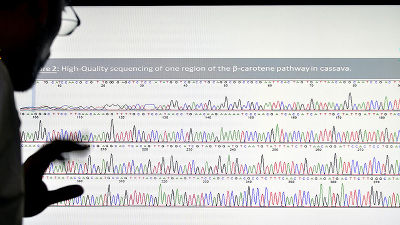Possibility of finding a new treatment from `` a woman who did not develop until the 70s although she is a family who is likely to become young Alzheimer ''

by
Alzheimer's disease is a disease with symptoms such as cognitive decline and personality changes, and many researchers continue to search for treatments, but no effective treatment has been established. Meanwhile, nearly 6,000 people connected with blood develop a juvenile Alzheimer's disease `` a family with a genetic mutation that is prone to juvenile Alzheimer's disease '', but a woman who did not become Alzheimer's disease until the 70s discovered It is attracting attention as a key to finding new treatments.
Resistance to autosomal dominant Alzheimer's disease in an APOE3 Christchurch homozygote: a case report | Nature Medicine
https://www.nature.com/articles/s41591-019-0611-3
Why Didn't She Get Alzheimer's? The Answer Could Hold a Key to Fighting the Disease-The New York Times
https://www.nytimes.com/2019/11/04/health/alzheimers-treatment-genetics.html
A family living in a mountain village on the outskirts of Medellin in Colombia has a very rare genetic mutation that is “prone to become juvenile Alzheimer”, and nearly 6,000 people connected to their families have juvenile Alzheimer's. . In this family, in general, problems in memory and thinking ability begin to occur in the 40s, and it rapidly deteriorates and dies when it is around 60 years old.
Because the Alzheimer's patient in this family has a specific cause and a consistent pattern of onset, experts have been investigating for many years to investigate this family to get helpful tips for treating Alzheimer's disease. It was. In the course of research, it has also been found that the cause of this family's predisposition to juvenile Alzheimer is a mutation in a gene called presenilin 1, which is a pathogenic gene associated with Alzheimer's disease.
In the meantime, a woman who did not suffer from Alzheimer's disease until her 70s was discovered while drawing the blood of a family that tends to become young Alzheimer's. This woman, like other humans in the family, had a presenilin 1 mutation, and was originally at the age of not only having Alzheimer's disease but also dying. However, it seems that this woman had no mild signs of Alzheimer's disease at the time of discovery.

by
The woman was invited to Boston, where the Alzheimer's research center is located, to perform a brain scan and other tests on the woman. As a result of examining the brain of a woman, it seems that the accumulation of a protein called amyloid, which is a prominent feature of Alzheimer's disease, was found in the brain, and it was diagnosed that it should have Alzheimer's disease.
Yakeel Quiroz, who is studying Alzheimer's disease at Massachusetts General Hospital, testifies that the test results of a woman were very incomprehensible. “The highest level of amyloid we have ever seen has accumulated,” Quiroz said. For this reason, Mr. Quiroz believes that women may have lived to an age that would otherwise have died of Alzheimer's disease, so more amyloid may have accumulated than other Alzheimer's patients.
However, despite the large accumulation of amyloid in the woman's brain, the woman was not experiencing cognitive problems. In addition, abnormally phosphorylated tau protein , which seems to be related to Alzheimer's disease as well as amyloid, was hardly confirmed, and neither neurodegeneration nor brain atrophy was observed.
“Her brain worked very well. Her brain was better than people aged 45 to 50,” Quiroz says. On the other hand, women can hardly read and write because they have been educated for only one year, and the reason why cognitive function is protected is not because of cognitive stimulation by advanced reading and writing.

by
Quiroz consulted Joseph Arboleda-Velasquez, her husband and cell biologist at Harvard Medical School, to analyze the female gene sequence. As a result, the woman was found to have a mutation in the apolipoprotein E (APOE) gene , which is said to be associated with the risk of Alzheimer's disease.
There are several types of APOE genes that make up one set of genotypes, and the woman in question had two APOE genes called “APOE3”. In addition, both of the two APOE3 genes that the woman has were found to have a gene mutation called “Christchurch” named after the New Zealand city where the mutation was found.
In past studies, a group with a Christchurch mutation in one of the APOE genes was found among the families that are likely to become young Alzheimer's women. However, this group, like other people, developed juvenile Alzheimer and did not have Alzheimer's disease, unlike the women studied in this study. Arboleda-Velasquez believes that this result came from the fact that not only one Christchurch mutation in women, but two of the genotypes were genetically mutated.
The mutation in women's APOE gene affected the binding of apolipoprotein E and glycoprotein compounds, which are involved in the diffusion of abnormally phosphorylated tau protein associated with Alzheimer's disease. In past experiments, it was discovered that the smaller the amount of apolipoprotein E variant bound to a glycoprotein compound, the less relevant it is to Alzheimer's disease. The team says that if there are Christchurch mutations in the two APOE genes, few glycoprotein compounds bind to apolipoprotein E mutants.

by ColiN00B
The fact that even women with a very high risk of juvenile Alzheimer's disease could avoid Alzheimer's disease by suppressing the binding of APOE and glycoprotein compounds is the key to creating a new treatment for Alzheimer's disease. There is a possibility. Dr. Guojun Bu, who studies apolipoprotein E at Mayo Clinic , a general hospital in Minnesota, suggests that this discovery may be promising for the treatment of Alzheimer's disease. I pointed out that
“New findings are very important for both research and therapeutic development,” Yadong Huang, who studies Alzheimer's disease at the Gladstone Institute , said. He also pointed out that women had confirmed amyloid accumulation but had no signs of Alzheimer's disease. “This study shows that amyloid accumulation is abnormally phosphorylated tau protein accumulation, neurodegeneration, cognition. It ’s the first time I know, showing a clear separation from the decline in functionality. ”
Related Posts:
in Science, Posted by log1h_ik







